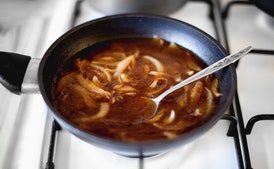
Introduction
Onion Gravy, a comforting and savory classic, brings together the simple yet flavorful essence of sautéed onions with creamy richness from beef broth. This dish is beloved for its ability to elevate various entrees, providing an irresepeatable depth in taste that invites appreciation and nostalgia.
Tips for this Recipe
- Ensure your onions are uniformly thinly sliced using a mandoline slicer or sharp knife to promote even cooking and caramelization.
- Maintaining medium heat while sautéing the onions prevents burning, preserving their natural sweetness that is fundamental for flavor development in the gravy.
- A good whisk or immersion blender can help achieve a smooth consistency when pureeing components together; this step enhances the velvety texture of the final product.
- While simmering, frequently stirring prevents sticking and ensures even reduction for a luscious gravy consistency.
Ingredients
- 1 medium onion, thinly sliced
- 1 tablespoon vegetable oil
- 1 tablespoon unsalted butter
- 1 1/2 tablespoons all-purpose flour
- 1 1/4 cups water
- 1 cup canned beef broth
- 1 tablespoon Worcestershire sauce
- 1/4 teaspoon black pepper
Adviced Equipment
- Skillet – Great for sautéing onions and simmering the gravy.
- Casserole Dish – Ideal for thickening sauces without spillage.
- Silicone Ladle – Useful for serving and pouring liquids with ease.
- Mandoline Slicer – Ensures uniform onion slices, contributing to even cooking.
- Blender or Immersion Blender (Stick Blender) – For pureeing ingredients and thickening the gravy.
- Soup Ladle – Efficient for serving onion gravy in a restaurant setting.
- Chef’s Knife – Essential for finely chopping ingredients, including dicing onions.
- Strainer – Helps to achieve a smooth texture by straining solids from the gravy.
- Heavy-bottomed Saucepan – Preferred for slow cooking and reducing sauces without burning.
History of the Recipe
The origins of onion gravy can be traced back to various culinary traditions, where it has been a staple in meals for centuries. Its simplicity and versatility have made it a go-to side dish or ingredient that complements many other dishes across different cultures.
- Onion gravy is often associated with American cuisine, where it pairs beautifully with roasts and mashed potatoes, especially in the context of holiday feasting.
- European versions may involve additional herbs or broths, reflecting regional preferences and cooking techniques. For example, French onion soup gravy often includes wine and cheese, highlighting a different aspect of flavor development.
- Throughout history, the preparation methods for onion gravy have evolved, but its popularity remains unwaayered due to its adaptability and rich taste profile that enhances various dishes without overshadowing their inherent qualities.
Fun Facts About This Recipe
Onion gravy is more than just a side dish—it’s a testament to the art of cooking. The caramelization process that onions undergo transforms their flavor profile dramatically, which in turn elevates an entire meal.
- Did you know? Some chefs swear by using specific types of onions—like Vidalia or Walla Walla—for a milder taste that complements the richness of beef broth without overpowering it.
- The technique for making silky smooth gravy often involves a ‘roux’ made from equal parts fat and flour, which is then combined with liquid. This method dates back to French cooking practices, showcasing the interplay between different cuisines through time.
- Traditional onion gravies may be prepared in large batches for family gatherings or holiday meals, indicating its role as a comfort food that brings people together.



